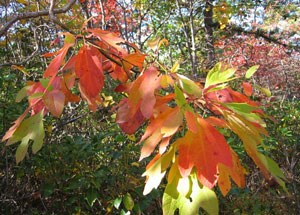
If you hike or drive through Shenandoah National Park you will be treated to sweeping views of forested hillsides. When you see the expanse of forested land extending away to the valley floor it is hard to imagine that things have ever been different than they appear today. However, when the park was established in 1935, logging, farming, grazing, and the chestnut blight had rendered one third of the park completely deforested, and the remaining land covered with brush and a very young regenerating forest. More recent disturbances such as the gypsy moth (Lymantria dispar) killed large numbers of oak trees in the early to mid-1990's. These large pale bark-less trees continue to be visible from many places on Skyline drive. Today Shenandoah NP is greater than 95% forested. Over half of the land is dominated by either chestnut or red oak forests situated on the ridge tops and upper slopes. Mid-slope positions support areas of mixed hardwood forests that include maple (Acer spp.), birch (Betula spp.), ash (Fraxinus spp.), and basswood (Tilia americana) trees. Yellow poplar (Liriodendron tulipifera) forests are found on the lower slopes and along streams. Approximately 20% or 267 of the vascular plant species documented in the Park are trees or shrubs. These species are most noticeable when their leaves change color in the Fall, but can be appreciated all year long. Early spring finds serviceberry (Amelanchier spp.) blooming, the white blossoms visible for long distances through the leafless forest. Mountain laurel (Kalmia latifolia) is one of the most common understory shrubs within the Park, and it is well known for its abundant pink blooms in June. In mid-Summer blackberries (Rubus spp.) and raspberries ripen in the open areas along trails and streams. Blueberries (Vaccinum spp.) and huckleberries (Rubus spp.) soon follow and are especially abundant in the dry oak forests of the Park. The Fall leaf color change typically peaks in mid-October. A walk or drive through the park at this time of year yields beautiful views of rich red-brown oaks (Quercus spp.), brilliant yellow birches and poplars, and the red and orange black gum (Nyssa sylvatica), sumac (Rhus spp.), maples, and Virginia creeper (Parthenocissus quinquefolia). NPSpecies ListsNPSpecies is a consolidated database where you can find the latest information on any species from any National Park Service unit. This resource lets you search for species information on specific parks and allows you to create your own itemized species lists. Select a Park:Select a Species Category (optional):
Search results will be displayed here.
Related Information Conners, J.A. 1988. Shenandoah National Park: An Interpretive Guide. McDonald and Woodward, Blacksburg, Virginia. Gupton, O.W. and F.C. Swope. 1981. Trees and Shrubs of Virginia. University Press of Virginia, Charlottesville, Virginia. Listing of this website does not and is not intended to imply endorsement by the National Park Service of commercial services or products associated with the sites. |
Last updated: March 27, 2024
